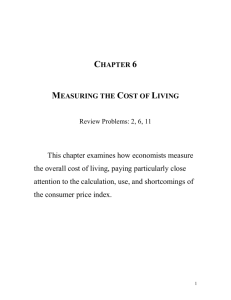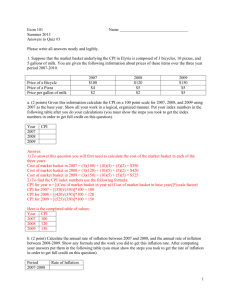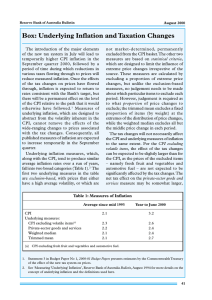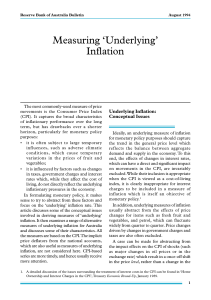Inflation notes
advertisement
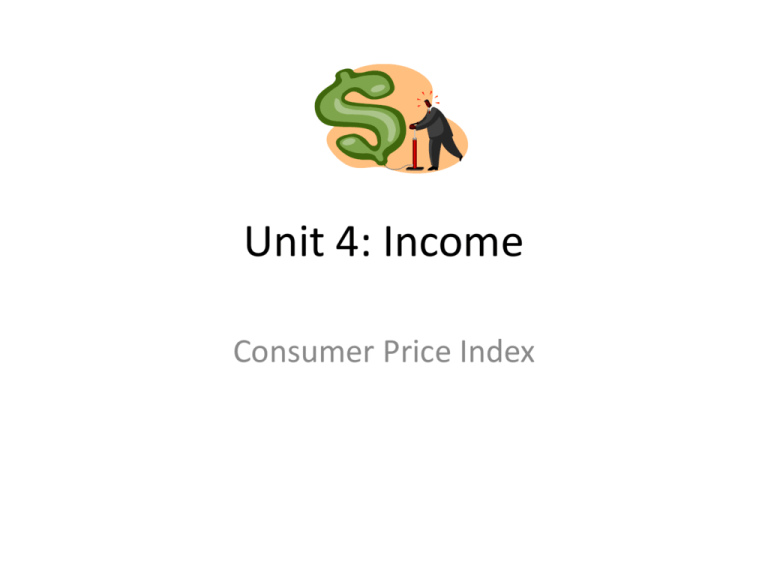
Unit 4: Income Consumer Price Index Inflation • Definition: The general increase of prices over time • A two-liter of Coca-Cola cost $0.99 in the year you were born (1995). What would that same bottle of Coke cost you today? • We’ll calculate the exact answer to this question in a little bit What Causes Inflation? There are three main theories that describe inflation: • The Quantity Theory • Demand-Pull Theory • Cost-Push Theory The Quantity Theory • This theory says that inflation is caused by too much money in the economy. MV = PT • M – amount of money in circulation • V – velocity of circulation of that money • P – average price level • T – number of transactions taking place M P Demand-Pull Theory • This theory says that inflation happens when the demand for goods and services exceeds existing supplies. • Examples: – Organic beef is growing in popularity, and there aren’t enough certified organic cows to meet the growing demand ==> price of organic beef goes up – Many people want Jordan’s artwork, but he only makes one of each design ==> price of art increases Cost-Push Theory • This theory says that inflation occurs when the cost of producing goods and services rise and that cost gets passed on to the consumer through higher prices. • Examples: – NHL union gains power ==> wages increase ==> hockey team owners’ cost increases ==> you pay more for tickets and goods at the stadium – Natural supply of fish decreases ==> fish prices increase ==> firms’ costs increase ==> you pay more at the store for fish Purchasing Power • Purchasing power describes the ability to buy goods and services • Based on the inflation calculator we looked at earlier, how has the purchasing power of $1 changed in your lifetime? Price Index • A price index is a way to illustrate how a regular group of goods and services changes over time. • The government uses the Consumer Price Index (CPI) to measure the change in prices of goods and services over time in our economy. • They measure a standard set of goods and services called a market basket to track changes in prices over time. Market Basket • The Bureau of Labor Statistics (BLS) measures goods and services called the market basket that most people buy on a monthly basis. • The BLS measures these prices every month to track changes. • What is in the market basket? Calculating Inflation-Adjusted Prices Inflation-adjusted price formula: Year 2 price = Year 1 price x (Year 2 CPI / Year 1 CPI) Calculating Inflation-Adjusted Prices Example 1 Let’s go back to the two-liter of Coke that cost $0.99 in the year you were born (1995). What would that same bottle of Coke cost you today? 2013 price = 1995 price x (2013 CPI / 1995 CPI) = $0.99 x (233.0/152.4) = $1.51 Is this about how much a two-liter of Coke actually costs today? Calculating Inflation-Adjusted Prices Example 2 In 2005, the median income was $46,326. What would have been an equivalent income in 1960? 1960 price = 2005 price x (1960 CPI / 2005 CPI) = $46,326 x (29.6/195.3) = $7,021.25 If the actual median income in 1960 was $5,600, were people earning more or less relative to the time period? Calculating Inflation-Adjusted Prices Example 3 Let’s compare the median income in 2005 ($46,326) to today’s median income. What is the inflationadjusted income today (use 2013 information)? 2013 price = 2005 price x (2013 CPI / 2005 CPI) = $46,326 x (233.0/195.3) = $55,268.60 If the actual median income in 2013 was $52,100, are people earning more or less relative to the time period? Calculating Inflation-Adjusted Prices In your groups… • Assign a manager, writer & calculator – Manager: get an activity worksheet – Writer & calculator: move the desks into a pod • Complete the activity • When you have a question, “ask 3 before me”




